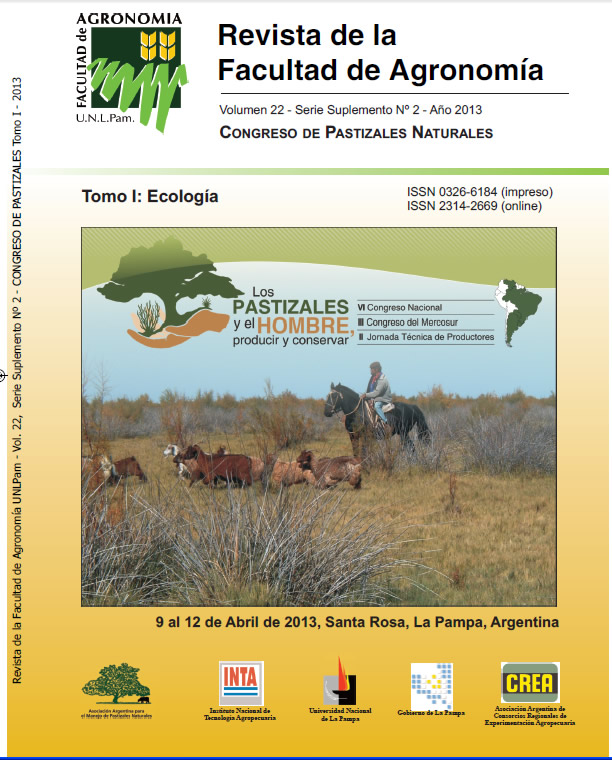Pregnancy rates in beef heifers reared on natural grasslands in rotational grazing
Keywords:
Degree-days, Rest between grazing, Pregnancy diagnosis, Pampa BiomeAbstract
Improvement of the reproductive efficiency of beef livestock herds in Rio Grande do Sul can be achieved either by reducing the age at first breeding of 30-36 months to 18-24 months as well as by increase of average pregnancy rate in the state. The aim of this study was to evaluate the pregnancy rate of beef heifers reared on natural grasslands under rotational grazing in Rio Grande do Sul. The treatments were two rest intervals between grazing, determined by the thermal sums of 375 and 750 degree-days (DD). Heifers used were of the Angus breed starting the experiment at 12 months of age. During the spring/summer, stocking rate was regulated for disappearing of 70% of grasses leaf blade. In autumn/winter stocking rate was fixed and the animals were supplemented daily with corn (0.5% of live weight). At two years of age, heifers of both treatments were bred for 60 days and were maintained on natural grassland under continuous grazing. Pregnancy diagnosis was performed 60 days after the breeding season. Heifers managed during rearing on 375 DD treatment had lower pregnancy rate (75%) when compared with those managed at 750 DD grazing intervals (100%) (P = 0.0001).The average pregnancy rate for both treatments was 85.71%. Treatment 750 DD, during rearing, provides best pregnancy rates. Average pregnancy rates were according to standards of intensive livestock for this category.
Downloads
References
Beretta V., J.F.P. Lobato & C.G.A. Mielitz Neto. 2001. Produtividade e eficiência biológica de sistemas pecuários de cria diferindo na idade das novilhas ao primeiro parto e na taxa de natalidade do rebanho no Rio Grande do Sul. Rev. Bras. Zootec. 30(4): 1278-1286.
Ferrel C.L. & T.G. Jenkins. 1984. Energy utilization by mature, nonpregnant, nonlactating cows of different types. J. Anim. Sci. 58: 234-243.
Lobato J.F.P. 1997. Sistemas intensivos de produção de carne bovina: 1.cria. In: Simposio sobre pecuaria de corte. Piracicaba: FEALQ-ESALQ. pp.161-204.
Mielitz Netto C.G.A. 1994. Modernização e diferenciação na bovinocultura de corte brasileira. Campinas. Tese (Doutorado em Economia) - Universidade Estadual de Campinas/Instituto de Economia. pp. 224.
Santos A.B. 2012. Morfogênese de gramíneas nativas do Rio Grande do Sul (Brasil) submetidas a pastoreio rotativo. Santa Maria. Dissertação (Mestrado em Agrobiologia) – Universidade Federal de Santa Maria. pp. 83.
SAS Institute. 2001 Statistical analysis system user’s guide. Version 8.2 Cary: Statistical Analysis System Institute.
SEBRAE/FARSUL/SENAR. 2005. Diagnóstico de sistemas de produção da bovino cultura de corte do Estado do Rio Grande do Sul. Relatório de Pesquisa, IEPE/UFRGS.Porto Alegre, Brasil. pp. 265.
Downloads
Published
Issue
Section
License
La Editorial de la Universidad Nacional de La Pampa (EdUNLPam) exigirá a los/as autores/as la firma del siguiente documento:
La EdUNLPam lleva a cabo la publicación del artículo: (Título del Artículo) en SEMIÁRIDA Rev.Fac.Agron UNLPam ISSN 2362-4337 (impresa) ISSN 2408-4077 (en línea), del cual el/los abajo firmantes son autores de una o más partes. En el mismo acto, el/los autores entregan exclusivamente a la EdUNLPam todos sus derechos protegidos por las leyes de propiedad intelectual que rigen en la Argentina para reproducir, publicar, editar, fijar, comunicar y transmitir públicamente en cualquier formato o medio impreso o electrónico, inclusive internet, el artículo enviado a publicación e incluirlo en índices o bases de datos nacionales e internacionales. A cambio, la EdUNLPam entrega a los autores la autorización para la publicación o reimpresión con ines académicos y educativos en cualquier libro o medio de divulgación, con la sola obligación de citar el artículo original publicado en la EdUNLPam. Cada autor acuerda en que el material provisto a la EdUNLPam es un trabajo original, que no ha sido impreso o publicado en cualquier otro medio con anterioridad y que no vulnera derechos de terceros. El Primer autor tendrá la posibilidad de leer y corregir el artículo ya editado como “prueba de galera”, pero si el autor no devolviera esas correcciones de la prueba de galera dentro del tiempo especificado, el proceso de producción y publicación podrá proseguir sin la aprobación del autor. El/los autor/es no recibirán compensación monetaria de la EdUNLPam por el uso del material contenido en este artículo y asumen la responsabilidad de las opiniones vertidas en él.






.png)



22.png)



.jpg)




.jpg)
